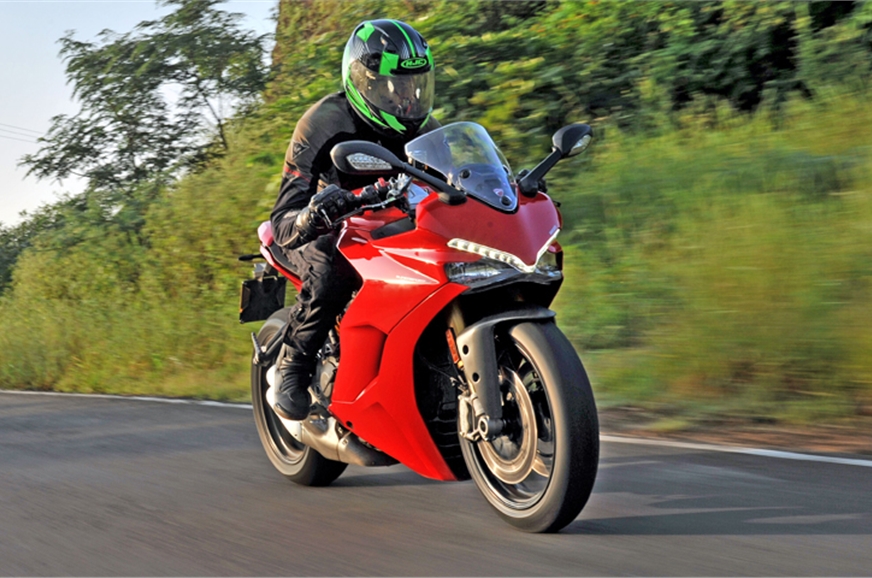
Compromise is often perceived as a negative, but the truth is that it’s a wonderful thing. Compromise ends wars, compromise saves relationships and most importantly, compromise results in happiness. The Ducati SuperSport is a compromise and I mean that in the most genuine sense of the word. The big question is whether this particular compromise can find you happiness. Let’s see, shall we.
Does it look the part?
A Ducati sports bike is the stuff of dreams, an object so desirable, entire childhood dreams and aspirations are based around its magical form. Therefore, it’s vital that the SuperSport take the breath away, and that she most certainly does. The Panigale-inspired face is entirely to thank here, with a sleek LED DRL running down the nose which sits atop a halogen headlamp. The design is carried off quite well, but the halogens have average performance and it’s about time we start seeing powerful LED lamps as standard on such expensive bikes.
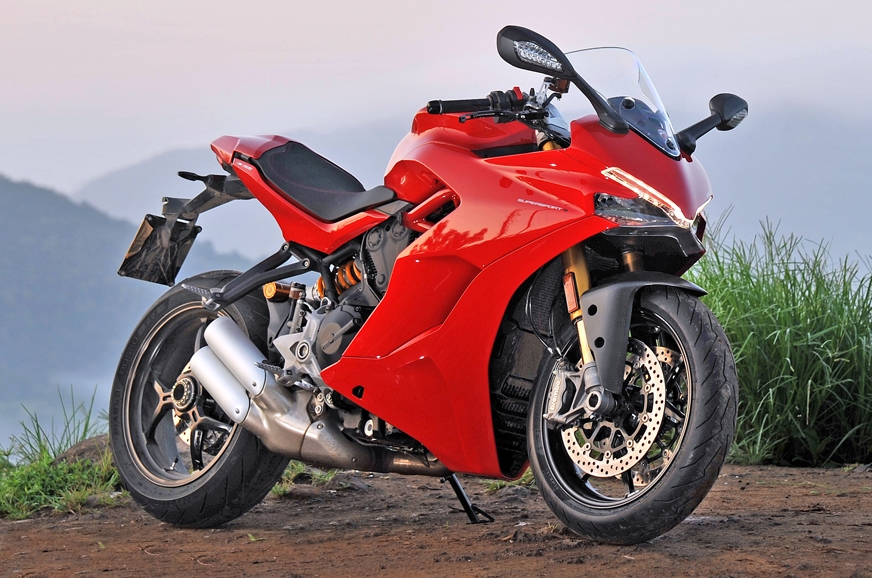
Moving over to the side, the design is noticeably less Panigale. From the images, the large fairing gives the bike a rather front-heavy look, but in person the design is quite svelte and easy on the eyes. The fairing features a unique shoulder line that blends into the fuel tank and clever design work has ensured that all screws and fasteners are hidden away. Things turn sexy once more as we move to the rear with the double-barrel exhaust stopping just short of the rear wheel. The entire rim is proudly on display on the right side thanks to a single-sided swingarm, something previously reserved for top-tier Ducatis like the Diavel/xDiavel, Multistrada 1200 and 1299 Panigale.
This particular bike is the higher-spec SuperSport S, so it gets the gold Ohlins front forks, a yellow Ohlins shock and a body-coloured rear-seat cowl. Our test bike was also wearing the optional Performance Pack, which, for about Rs 60,000, adds a carbon-fibre front fender, sleek LED indicators, adjustable levers and CNC machined caps for the brake fluid reservoirs.
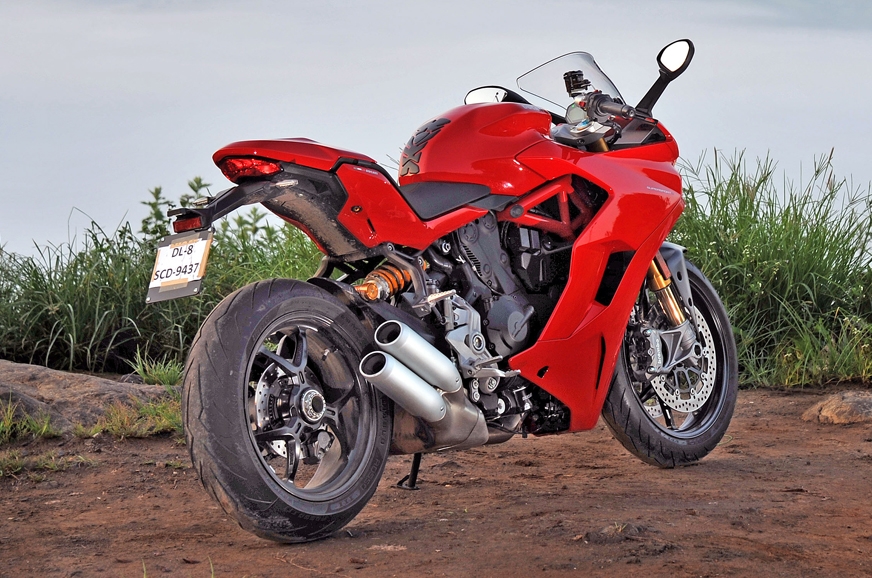
Facing the rider is an LCD screen which relays all the relevant information and is easy to read in bright daylight. Another smart design feature is the incorporation of body-coloured panels connecting the front of the fairing to the fuel tank. It’s a splash of prettiness in a space that is usually filled with drab black plastic and I quite like it. Ducati’s traditional sliding start switch resides on the right bar, while the left has the controls for the digital display. There’s another button on the right that allows you to switch between the big DRL and the full headlamp. Overall, the SuperSport is well finished, but it would be nice if the exposed engine area behind the fairing was more cleaned-up, as there’s quite a lot going on with the exposed plumbing and wiring.
Is it a proper performance motorcycle?
Nestled in the SuperSport’s steel trellis frame is a big, 937cc V-Twin engine. Given the proximity to a full litre of capacity, it’s easy to expect humongous power figures. The reality is that the SuperSport’s motor favours rideability over big numbers. At 110hp and 93Nm, power and torque is considerably down from the 150hp and 102Nm of torque produced by the (completely different) 955cc V-Twin in the 959 Panigale. Ducati have instead made a conscious decision to ensure that the SuperSport’s power and torque is accessible far more easily. Torque peaks at 6,500rpm, a whole 2,500rpm before the 959 Panigale, but more importantly, the rider has access to 80 percent of the torque at just 3,000rpm. However, like most big V-twins, the SuperSport engine feels lumpy at low revs and has a dislike for anything below 2,000rpm.
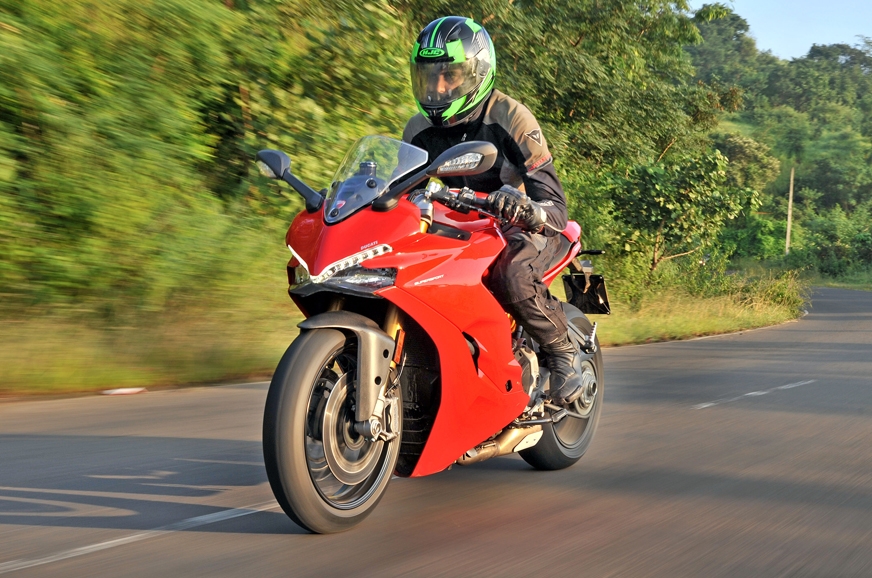
Our test bike had clocked only 600km and it had a couple of minor rough spots, but experience with the Multistrada 950 reminds us that this motor is smooth and hard revving, while remaining free of any annoying vibrations. It sounds good too, with the exhaust belting out a loud and deep rumble and it throws out some nice burbles and pops on a closed throttle. Performance is thrilling, but stops short of the level where you scream into your helmet in sheer awe at how violently the bike is accelerating. Power builds hard, but in a friendly, linear fashion and speeds upwards of 160kph can arrive very quickly if you aren’t paying attention.
Of the three riding modes, Urban blunts throttle response and power to the point where it is highly beginner-friendly, but rather frustrating to the more experienced. Touring mode strikes the best balance, as it provides full power with a smooth and mellow throttle response. Sport mode, meanwhile, offers sharper responses, yet remains creamy and easy to control with the right hand. As with the Multistrada 950, the traction control system is delightfully unobstructive and offers eight levels of adjustability.
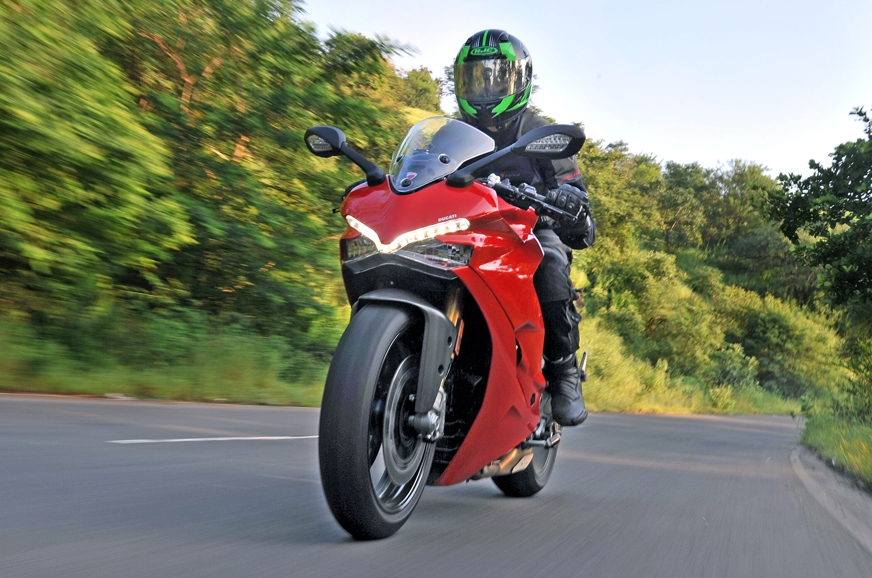
The six-speed gearbox is precise, but, typical of a Ducati, it feels a bit heavy and is sometimes reluctant to slip into neutral. On the SuperSport S, however, it comes with an extra party trick in the form of an up/down quickshifter. This is the first bike at this price point to offer a bi-directional quick shifter and it’s a delight to use. As with a normal quickshifter, which allows you to shift up through the gears without using the clutch, the downshift function means you can arrive hard on the brakes into a corner, press down the gear lever firmly with your left foot and leave the bike to do the rest. With a closed throttle, the ECU blips it with an appropriate amount and slots in the lower gear with complete smoothness. It takes a while to trust the system, but then on, it’s a joy to use. I did encounter the rare jerky shift in the lower gears, but I suspect this will smooth out as the bike runs in fully.
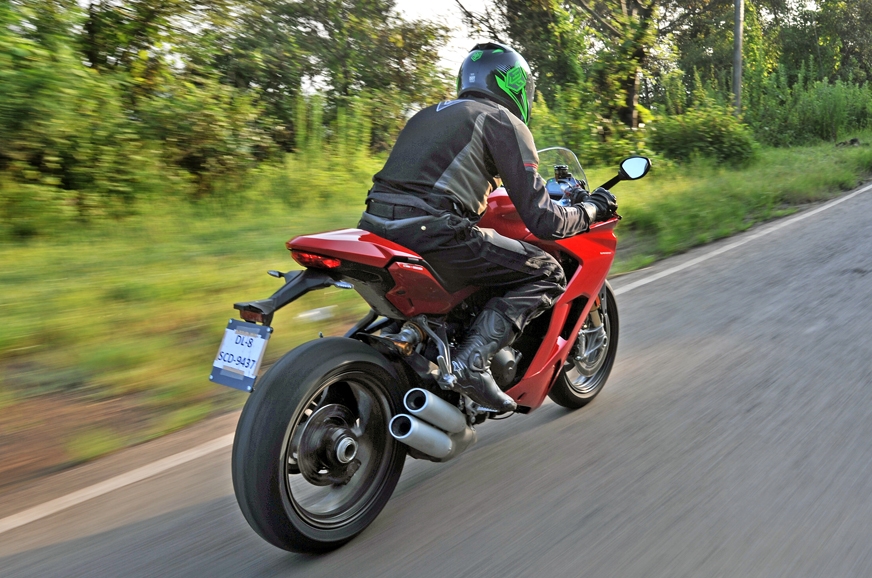
Is it really the practical superbike?
This is the aspect of the SuperSport where we address compromise. Starting with the riding position, it’s a fair bit sportier than typical sport tourers, with rather high-set pegs and a fair stretch forward to the bars, but it stops short of being too much. I hopped on a 959 Panigale immediately after, and the difference is stark. The SuperSport feels sporty, while the Panigale is all-out committed. On the SuperSport, I’d happily spend many hours in its wide and comfy seat, but the Panigale becomes painful quite quickly. The SuperSport’s big V-Twin runs quite hot, but once again, the Panigale, with its bend pipe right under the seat, is on a different level of discomfort.
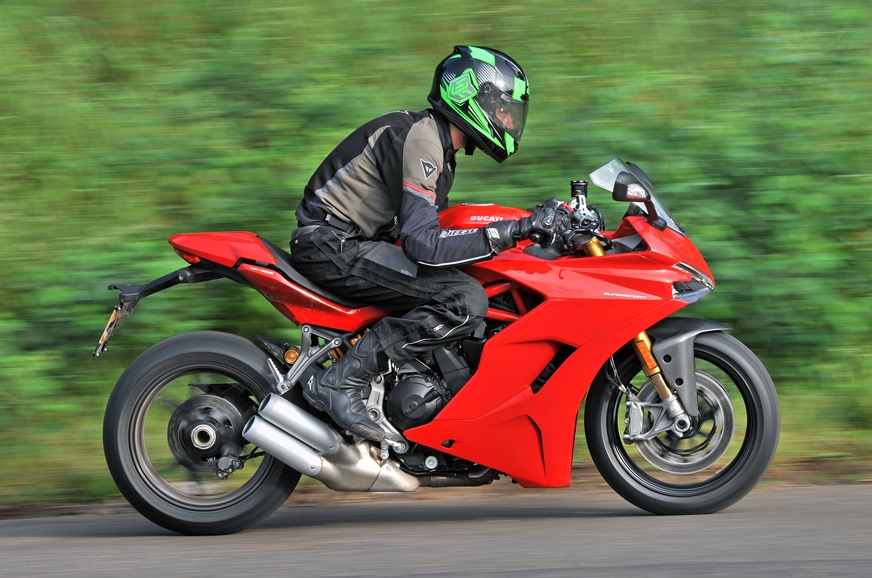
The SuperSport comes shod with Pirelli’s new Diablo Rosso III tyres and they’re a joy in wet or dry conditions. We had a chance to play on some winding roads and the SuperSport is a willing partner. The slim-feeling bike is easy to manage and the chassis has a thoroughly neutral feel. While it lacks the agility and response of something like a Street Triple, it feels far lighter on its feet than the typical 1,000cc sport tourer from, say, Kawasaki or Suzuki. With 48 degrees of cornering clearance, there’s plenty of scope for attacking the corners and you could even enjoy the bike at a racetrack. Further support comes from the high-spec Brembo M4.32 brakes that have been tuned for friendly bite, but offer strong performance when called for. The three-stage ABS system is almost transparent as it watches over you from the background
I did have a couple of ergonomic issues with the bike, though. The trellis frame ends in a slightly raised section below the fuel tank and is covered by a black plastic cap. While this doesn’t cause suffering, it makes constant contact with the legs when you’re gripping the tank. Second, on full lock, the handlebar tends to press your thumb (with a glove on) into the fuel tank while taking u-turns. It stops short of causing pain, but it can be surprising and you need to be aware that it’s going to happen.
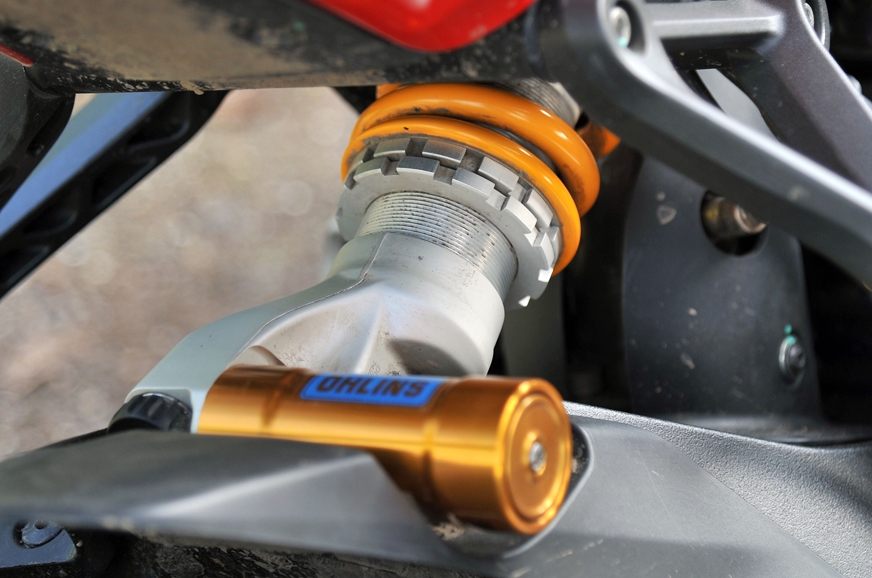
One of the prime reasons to pay the extra cash for a SuperSport is the fully adjustable Ohlins suspension. The system is highly impressive, and, despite being sprung quite sportily, the excellent damping soaks up imperfections beautifully. We aimed the bike at some completely broken roads for a short while and it got through without creating the feeling that something is about to break. Naturally, it prefers good roads, but the important thing is that it is capable enough to get through bad stretches without too much discomfort. Ground clearance is fairly decent as well, and with some care over sharp speed breakers, there isn’t too much cause for concern. The standard SuperSport on its Marzocchi/Sachs suspension has a lot to live up to on our roads.
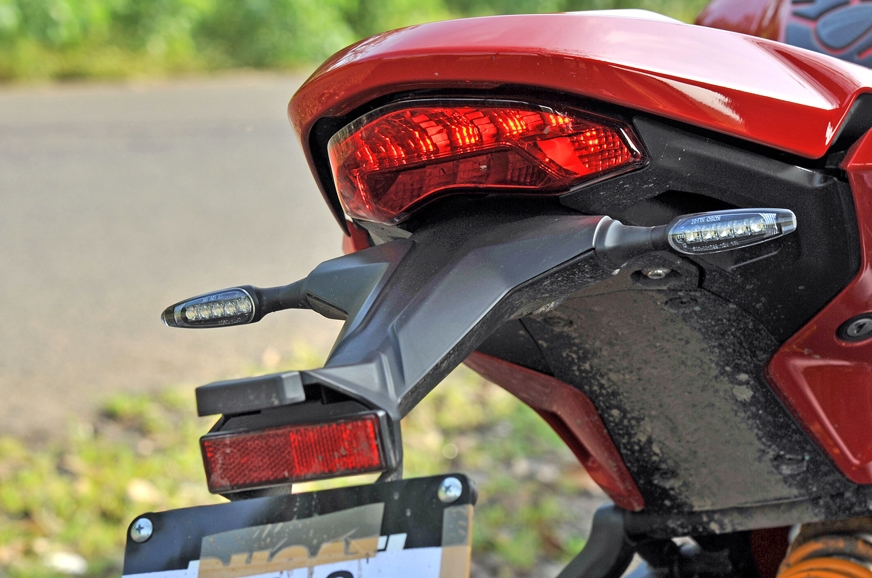
Should I buy one?
One of the things that struck me most about the SuperSport is that you can enjoy this bike without pushing it to its limit. That’s not something you can say for most high-strung superbikes, 959 Panigale included. It certainly lacks the outright punch of the similarly priced Suzuki GSX-S1000F or Kawasaki’s amazingly priced Ninja 1000 (which came in very few numbers), but makes up for it in other areas. The SuperSport S is considerably more dynamic than the other two, offers a refined electronics package and is a much prettier machine. At Rs 13.39 lakh (ex-showroom, India), the SuperSport S isn’t exactly tremendous value and you could have the more exotic 959 Panigale for about Rs 1.19 lakh more. But Ducati’s aren’t about value, they’re about the experience. In that sense, the SuperSport is the real deal, while just so happening to be that much easier to enjoy. A happy compromise indeed.
[“Source-autocarindia”]





